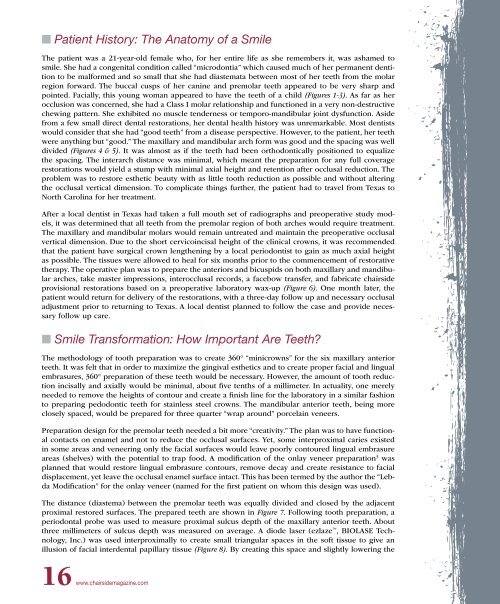PDF Version - Glidewell Dental Labs
PDF Version - Glidewell Dental Labs
PDF Version - Glidewell Dental Labs
Create successful ePaper yourself
Turn your PDF publications into a flip-book with our unique Google optimized e-Paper software.
■ Patient History: The Anatomy of a Smile<br />
The patient was a 21-year-old female who, for her entire life as she remembers it, was ashamed to<br />
smile. She had a congenital condition called “microdontia” which caused much of her permanent dentition<br />
to be malformed and so small that she had diastemata between most of her teeth from the molar<br />
region forward. The buccal cusps of her canine and premolar teeth appeared to be very sharp and<br />
pointed. Facially, this young woman appeared to have the teeth of a child (Figures 1-3). As far as her<br />
occlusion was concerned, she had a Class I molar relationship and functioned in a very non-destructive<br />
chewing pattern. She exhibited no muscle tenderness or temporo-mandibular joint dysfunction. Aside<br />
from a few small direct dental restorations, her dental health history was unremarkable. Most dentists<br />
would consider that she had “good teeth” from a disease perspective. However, to the patient, her teeth<br />
were anything but “good.” The maxillary and mandibular arch form was good and the spacing was well<br />
divided (Figures 4 & 5). It was almost as if the teeth had been orthodontically positioned to equalize<br />
the spacing. The interarch distance was minimal, which meant the preparation for any full coverage<br />
restorations would yield a stump with minimal axial height and retention after occlusal reduction. The<br />
problem was to restore esthetic beauty with as little tooth reduction as possible and without altering<br />
the occlusal vertical dimension. To complicate things further, the patient had to travel from Texas to<br />
North Carolina for her treatment.<br />
After a local dentist in Texas had taken a full mouth set of radiographs and preoperative study models,<br />
it was determined that all teeth from the premolar region of both arches would require treatment.<br />
The maxillary and mandibular molars would remain untreated and maintain the preoperative occlusal<br />
vertical dimension. Due to the short cervicoincisal height of the clinical crowns, it was recommended<br />
that the patient have surgical crown lengthening by a local periodontist to gain as much axial height<br />
as possible. The tissues were allowed to heal for six months prior to the commencement of restorative<br />
therapy. The operative plan was to prepare the anteriors and bicuspids on both maxillary and mandibular<br />
arches, take master impressions, interocclusal records, a facebow transfer, and fabricate chairside<br />
provisional restorations based on a preoperative laboratory wax-up (Figure 6). One month later, the<br />
patient would return for delivery of the restorations, with a three-day follow up and necessary occlusal<br />
adjustment prior to returning to Texas. A local dentist planned to follow the case and provide necessary<br />
follow up care.<br />
■ Smile Transformation: How Important Are Teeth?<br />
The methodology of tooth preparation was to create 360° “minicrowns” for the six maxillary anterior<br />
teeth. It was felt that in order to maximize the gingival esthetics and to create proper facial and lingual<br />
embrasures, 360° preparation of these teeth would be necessary. However, the amount of tooth reduction<br />
incisally and axially would be minimal, about five tenths of a millimeter. In actuality, one merely<br />
needed to remove the heights of contour and create a finish line for the laboratory in a similar fashion<br />
to preparing pedodontic teeth for stainless steel crowns. The mandibular anterior teeth, being more<br />
closely spaced, would be prepared for three quarter “wrap around” porcelain veneers.<br />
Preparation design for the premolar teeth needed a bit more “creativity.” The plan was to have functional<br />
contacts on enamel and not to reduce the occlusal surfaces. Yet, some interproximal caries existed<br />
in some areas and veneering only the facial surfaces would leave poorly contoured lingual embrasure<br />
areas (shelves) with the potential to trap food. A modification of the onlay veneer preparation 3 was<br />
planned that would restore lingual embrasure contours, remove decay and create resistance to facial<br />
displacement, yet leave the occlusal enamel surface intact. This has been termed by the author the “Lebda<br />
Modification” for the onlay veneer (named for the first patient on whom this design was used).<br />
The distance (diastema) between the premolar teeth was equally divided and closed by the adjacent<br />
proximal restored surfaces. The prepared teeth are shown in Figure 7. Following tooth preparation, a<br />
periodontal probe was used to measure proximal sulcus depth of the maxillary anterior teeth. About<br />
three millimeters of sulcus depth was measured on average. A diode laser (ezlaze , BIOLASE Technology,<br />
Inc.) was used interproximally to create small triangular spaces in the soft tissue to give an<br />
illusion of facial interdental papillary tissue (Figure 8). By creating this space and slightly lowering the<br />
16 www.chairsidemagazine.com
















